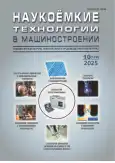SPECIAL FEATURES OF WELD FORMATION FOR LASER WELDING OF SHEET STEEL 09MN2SI
- Авторлар: Guzanov B.N.1, Anahov S.V.1, Michurov N.S.2, Bilalov D.K.3
-
Мекемелер:
- Ural State Pedagogical University
- Ural Institute of the State Fire Service of the Ministry of Emergency Situations of Russia
- Ural State Pedagogical University, Institute of Engineering and Pedagogical Education
- Шығарылым: № 10 (172) (2025)
- Беттер: 12-22
- Бөлім: Welding, related processes and technologies
- URL: https://bakhtiniada.ru/2223-4608/article/view/349988
- DOI: https://doi.org/10.30987/2223-4608-2025-10-12-22
- ID: 349988
Дәйексөз келтіру
Толық мәтін
Аннотация
Studies of special features for the formation of the structure and permanent joints properties during laser welding of 09mn2si sheet steel obtained after narrow-stream plasma cutting with a new PMVR-5.3 type plasma torch without additional machining of the gouging welds are presented. More efficient operation of the gas dynamic stabilization system for PTA of this plasma torch improves the cutting quality and, as a result, increases the absorption coefficients of radiation, penetration and laser welding performance. It is shown that a carbon dioxide laser welding contributes to a weld joint formation having a «dagger» shape and structure with a weld zone and an adjacent heat-affected zone (HAZ) on both sides of the CLW. At the same time, HAZ is heterogeneous in structure and consists of two subzones – overheating and normalization. In the weld zone, an increase in the hardness of the base metal is noted, and the distribution itself is symmetrical with respect to the CLW and fully reflects the location and extent of the crystallization and heat-affected zones in accordance with the data of metallographic analysis. In this case, the maximum value of microhardness is observed near the CLW, where a finely dispersed troostite-type structure is formed during crystallization. It is shown that the developed complex cutting and welding technology does not change the chemical composition of the steel in the weld vicinity. Based on the results of mechanical tests, conclusions were drawn about an increase in strength by about 30...35 % and impact strength with a slight decrease in the ductility of weld-in connections, as well as the absence of microcracks, unwelded spots and stretching of metal when stripping along fusion lines, which proves high quality of laser welding using the proposed technology.
Негізгі сөздер
Авторлар туралы
Boris Guzanov
Ural State Pedagogical University
Email: s_anakhov@yahoo.com
ORCID iD: 0000-0001-5698-0018
professor, doctor of technical sciences
Sergey Anahov
Ural State Pedagogical University
Email: s_anakhov@yahoo.com
ORCID iD: 0000-0003-1460-6305
docent, doctor of technical sciences, candidate of physical and mathematical sciences
Nikolay Michurov
Ural Institute of the State Fire Service of the Ministry of Emergency Situations of Russia
Email: s_anakhov@yahoo.com
ORCID iD: 0000-0003-1775-6181
Damir Bilalov
Ural State Pedagogical University, Institute of Engineering and Pedagogical Education
Хат алмасуға жауапты Автор.
Email: s_anakhov@yahoo.com
ORCID iD: 0000-0002-4336-5339
candidate of technical sciences
Әдебиет тізімі
Ленчик И.В., Родионова И.Н., Горохов А.Н. Проблемы и перспективы развития сварочного производства в России // Современные материалы, техника и технологии. 2016. № 1 (4). С. 134−137. Горшкова О.О. Новые технологии в сварочном производстве // Современные наукоёмкие технологии. 2021. № 2. С. 14−18. Юсупов Б.Д., Садуллаев З.Ш. Формирование состава и структуры металла шва и околошовной зоны при сварке плавлением // Экономика и социум. 2024. № 12 (127). С. 1−11. Игнатов А.Г., Козлов А.В., Скрипченко В.И. Лазерная сварка со сквозным проплавлением сталей различных классов // Автоматическая сварка. 1987. № 9. С. 26−29. Соколов М.А., Салминен А. Повышение эффективности сварки лазерным лучом // Инженерия. 2014. № 6. С.559−571. Соколов М.А., Салминен А. Влияние качества поверхности кромки соединения на эффективность лазерной сварки низколегированных сталей // Автоматическая сварка. 2013. № 2. С. 49−53. Riccardi G., Cantello M. Laser material interactions: Fbsorption coefficient in welding and surface treatment // CIRP Annals – Manufacturing Technology. 1994. V. 1. Pp. 171−175. Sokolov M.А., Salminen A. Experimental investigation of the influence of edge morphology in high power fiber laser welding // Physics Procedia. 2012. V. 39. Pp. 33−42. Анахов С.В., Гузанов Б.Н., Матушкин А.В. Исследование эффективности применения нового устройства для воздушно-плазменной резки листовой легированной стали // Вестник Пермского национального исследовательского политехнического университета. Машиностроение, материаловедение. 2022. № 4. С. 67−77. Анахов С.В., Гузанов Б.Н., Матушкин А.В. Разработка оборудования и технологии прецизионной воздушно-плазменной резки толстолистовой стали // Известия высших учебных заведений. Черная металлургия. 2022. Т. 65. № 1. С. 38−47. Sokolov M.А., Salminen A., Somonov V.V., Kaplan A.F. Laser welding of structural steels: Influence of edge roughness level // Optics & Laser Technology. 2012. V. 44 (7). Pp. 2064−2071. Баранов Д.А., Паркин А.А., Жаткин С.С. Особенности формирования сварного шва жаропрочного сплава ХН45ВМТЮБР в зависимости от режимов лазерной сварки // Известия Самарского НЦ РАН. 2018. Т. 20. № 4 (2). С. 170−176. Колубаев В.А., Сизова О.В., Колубаев Е.А. Особенности структуры сварного шва при лазерной сварке конструкционной стали 09Г2СЧ // Обработка металлов (технология, оборудование, инструменты). 2018. Т. 20. № 3. С. 123−133. Ломакин Е.В., Мельшанов А.Ф. Поведение малоуглеродистых сталей при растяжении // Известия АН СССР. МТТ. 1971. № 4. C. 150−158. Игнатов А.Г. Лазерная сварка сталей мощными CO2 лазерами. Часть 2. // Фотоника. 2009. № 3. С. 22−24.
Қосымша файлдар









